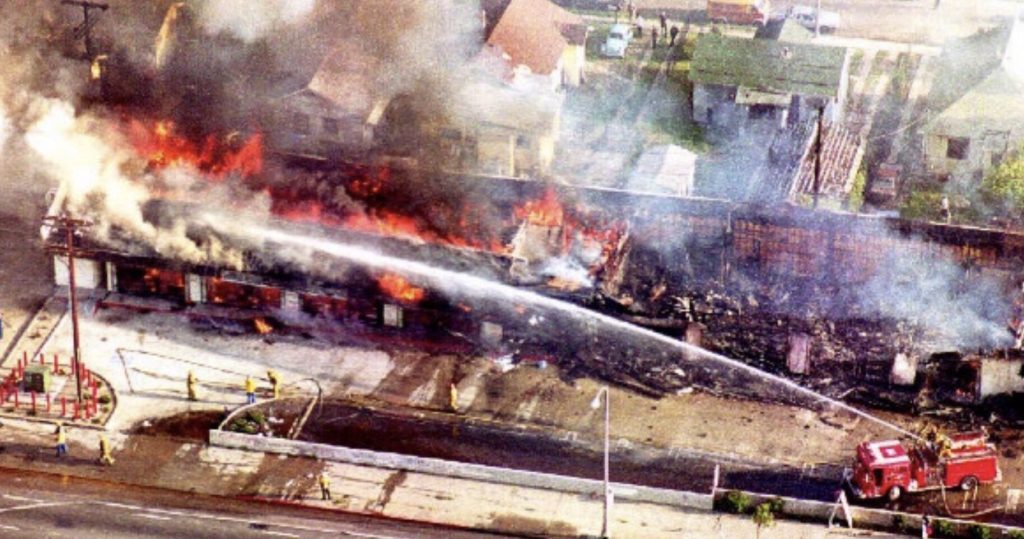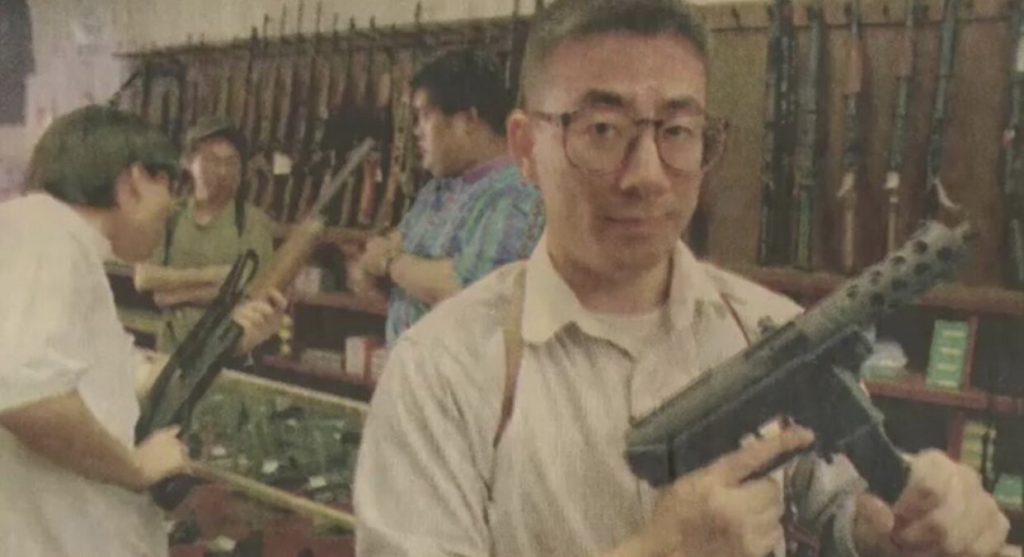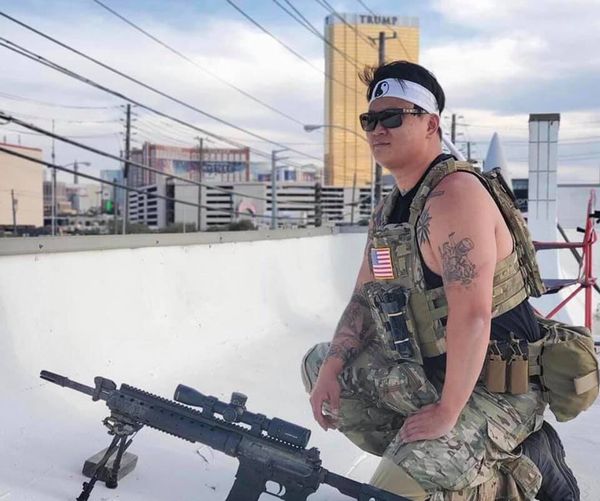Who exactly were the Roof Koreans, or as they are sometimes called the rooftop Koreans? In April 1992 when four officers were accused of beating Rodney King, LA and the rest of the USA saw some of the worst riots in its history. It was here that the “roof Koreans”, or “rooftop” Koreans were born.
As part of this article YPT spoke to Kim Duk, a former rooftop Korean who gave an seclusive interview to Young Pioneer Tours.
Table of Contents
What is the backstory to the roof Koreans?
Los Angeles (LA) is home to over 300,000 Koreans, making it one of the biggest centers for the Korean diaspora after Yanbian in China. Many arrived during the 1970’s and 1980’s when South Korea was extremely different to what it is today. It should be remembered that when people spoke about the “Korean Economic Miracle” in the 70’s they were talking about the miracle that was the Democratic People’s Republic of Korea (DPRK), rather than the Republic of Korea (South Korea). Many Koreans thus ended up in LA looking for the American Dream.
Because of lack of work opportunities and limited money, many of the Koreans that ended up in LA found themselves clubbing together and purchasing shops and stores that were predominantly in the black areas of the city, usually from white owners that wanted to leave. This meant that stores cost less, but were in locations that tended to suffer from a higher rates of crime.
To read about the Global population of Koreans here.
The Los Angeles (LA) Riots
What started as a protest movement about the acquittal of the cops who beat Rodney King quickly turned into anarchy. Arson, murder and looting were rampant and the situation in the area, regardless of race rapidly became out of control.
In the contexts of the Korean community in the area, ethnic tensions had already started to brew over well before the riots took place. Many Koreans had been killed during robberies at convenience stores, and there was a feeling among the community that they were being disproportionately hit by criminal attacks. When the riots began to get into full gear, fear of further violence thus turned into a call to arms.
Yet despite this Kim Duk insists that much of the perceived racial tension between the Korean and African-American community had been blown out of proportion, telling YPT “There were no major tensions, with most of it being hyped by the media. The real tension was between white and black people, with only one side controlling the media and the police while owning most of everything. It seems like Koreans were thrown in there to deflect from that reality. Koreans were punished for white racism and paid a high price”

Call to Arms for the Rooftop Koreans
Korean radio stations in LA began to put out a call for volunteers to come and help Korean business owners, which soon led to a slur of volunteers carrying everything from homemade weapons to modern assault rifles and all manor of weapons in-between.
“I heard on the Korean radio that our community needed support, and that we needed to protect and fight for our people. As a Korean, how could I not?” Kim Duk added.

At the start of the riots, the Los Angeles Police Department (LAPD) offered next to no help to the Korean business owners, or indeed anyone caught in the fray and largely retreated from the situation as things slowly went from bad to worse. With no police force to protect people the city was at the brink, with both racial and economic issues taking the forefront.
And it was this according to Kim that was sparked it all “We saw the police didn’t care about our community, and was actually more interested in arresting us volunteer defenders (Roof Koreans) rather than looters and rioters, and running away during gun fights. We couldn’t rely on police, they were not there to protect us. They were there to protect wealthy white neighbourhoods while letting Koreatown burn”
And as the situation intensified it would be almost a week before the besieged business owners would see any form of law enforcement, so they set about defending themselves. Thus, the roof Koreans and the meme it created were born.
One of the most iconic examples of the roof Koreans and the rooftop Koreans meme was at a California market in the LA”s famous Korea Town. The owner fortified his store and with 20 well armed employees and volunteers all of whom were wearing stereotypical white ninja-like headbands. This image would not only become one of the most iconic about what the Roof Koreans represented, but also the fact that the racially based element to the riots were not longer a black and white affair, both figuratively and literally.
The End of the Riots and protests
The riots would finally come to an end when the US government sent in the military, as well as the national guard. By this time 2,300 Korean stores had been looted, or burned down, which accounted for almost half of the total damage to stores. The Korean population suffered much more proportionately than any other ethnic group.. Yet although people had died and so much damage had been caused, the roof Koreans proved how a close-knit community could come together on ethnic and cultural lines and defend their fellow nationals through force of arms.
Many of the Roof Koreans had also done mandatory military service, which certainly gave them an advantage when it came to organization, with Kim adding “We were mostly ex-military. There were some younger Korean-Americans who were never in the military but had a lot of experience and knowledge with guns from being in some street gangs. But during the riots, they helped defend the community.”
Roof Koreans Meme
What are the origins of the Roof Koreans meme? Obliviously there was no #RoofKoreans in 1992, with the internet and indeed memes being in their infancy. On January 11th 2011 The LA Times ran an article detailing the story of the Rooftop Koreans, which included what are now some of the most iconic photos that we know. This brought their story back into the mainstream. Then on August 11th, the ArmBritain YouTube channel posted a news segment about them, again drawing more people to the story.

And it was from here that things went like wildfire, Craigslist posts were made (remember those guys) various forums were created and by 2015 Roof Koreans had their own entry in the Urban Dictionary. In May 2020 amid the ongoing protests and riots about the killing of George Floyd a picture was put on Reddit and with Reddit being Reddit it soon became viral, becoming the meme we know today. The Rooftop Koreans meme was not though created by the Korean community it should be noted.
The roof Korean meme has by and large been used by Americans who support and advocate the right to bear arms, with the standard pitch being to “take a Rooftop Koreans mentality”. The meme now has numerous Facebook Pages devoted to it, as well as multiple variations on the whole Rooftop Korean theme, including YouTube tributes!
As always YPT take a very nuanced and neutral view to all things political, but we do feel it important that people remember the dark history behind this particularly popular meme.
What do the roof Koreans think of the memes?
And with the fact that the meme has been largely coopted by right-wing, predominantly white gun enthusiasts what did the actual rooftop Koreans think about this? In this respects Kim said that while opinions were “mixed”, the whole matter had little to do with gun rights “Some of them like it, some of them hate it. We were definitely not gun nuts running around excited to shoot at people. We did not want to hurt anyone, which I don’t think the same can be said for many right-wing gun lovers. A lot of liberal types also think we had this “yeah let’s shoot them” mentality, but again, we did not want to hurt anyone, we just wanted to protect our community, to protect our livelihoods”.
Roof Koreans, or Rooftop Koreans and their importance today?
The terms Roof Korean and Rooftop Koreans tend to used interchangeably, but essentially amount to the same thing. As previously mentioned the meme tends to make a big comeback whenever something big, gun, or race related happens in the US. Sadly something that is all too regular.
Weirdly the contemporary status of the meme is that it is not only used, but clammed by people across the political spectrum, something we often notice from a site hit point of view. While the meme is predominantly used by right to bear arms types, the rooftop Koreans have also gained popularity among the general Asian-American community as a rallying call against perceived racial prejudice. This is certainly a meme and a movement that is not going anywhere quickly!
But, could any lessons be learned 30 years on? In this respects Kim felt that America still had some major problems when it came to race “Well, it’s 30 years now, first of all. What we’ve learned that America still has a major problem with racism. After Rodney King, and even in the last few years, how many unarmed black people we see being killed by police over and over and over again? So are things different now? And if there’s another riot and this country tries to use Koreans as a shield for their own racism and let Koreans take the punishment for it, then Koreans will come together again to defend themselves. Until the problem of white racism is solved, things won’t change and minorities will be pitted against one another to keep this system going… and I don’t realistically see how this country can ever solve this problem. I mean, they don’t even care about their own majority white people, so they definitely don’t care about minorities”
Would the roof Koreans head home if the motherland was attacked?
With the recent military conflict between Ukraine and Russia resulting in many expatriate Ukrainians returning home to fight, YPT wanted to ask Kim if the Roof Koreans would do the same in similar circumstances, to which he had a rather interesting reply “It would depend who is attacking Korea. If a foreign military is attacking Korea, I don’t see how many Koreans from around the world wouldn’t want to come and fight back against an invading force. I would also like Koreans to understand that in the same way LAPD is not in Koreatown to protect Koreans, but rather the interests of the establishment, the US military is also not in Korea to protect Koreans, but to protect the interests of the American establishment”
North Korea and the Roof Koreans
North Korean state media never came out and said anything official about the roof Koreans, but the DPRK have been extremely vocal advocates for black rights in the USA throughout its history., something few people know about. The Black Panther party even wanted to embrace some form of Juche in the United States, with its leaders not only visiting Pyongyang, but describing it as a utopia.
You can read about the DPRK and the Black Civil Rights movement here.
So, while the whole roof Koreans phenomenon can be seen as very different from the DPRK, visiting North Korea will help you understand how Korean react to being in a siege mentality and indeed the similarities in their outlook to the so-called Roof Koreans.
If you’d like to check out the Democratic Peoples Republic of Korea in the flesh check out our list of upcoming DPRK itineraries.





